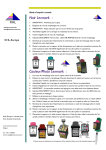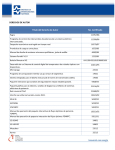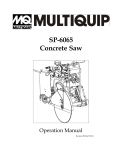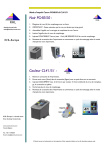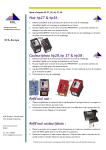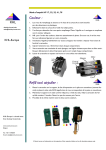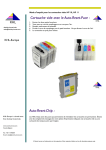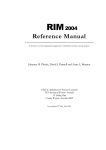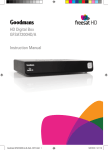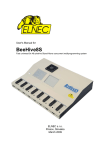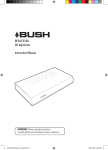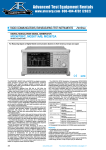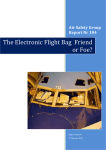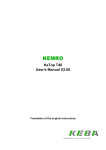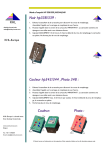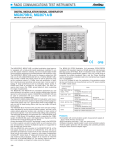Download Operating Manual UK S-Series
Transcript
Air Burners, LLC UK (European) S-Series Air Curtain Burner (Kubota V2003-TE Engine) OPERATING MANUAL Operating Manual UK (European) S-300 S-Series SeriesAir Burners Equipped With Kubota V2003-TE V3300-TE Diesel Engine Self Contained Refractory Walled Air Curtain Burner “The Environmentally “The green wood Friendly processing Alternative machines to Open” Burning” UK DEALER: Kingwell Holdings Ltd. Cordons Farm Depot Long Green Cressing Braintree Essex, CM77 8DL Phone: 01376 550989 FAX: 01376 551455 [email protected] www.kingwell-holdings.co.uk US Factory and Main Office Air Burners, LLC 4390 Cargo Way Palm City, FL 34990 Phone: 772-220-7303 or 888-566-3900 FAX: 772-220-7302 E-mail: [email protected] Web: www.airburners.com © 1998-2005, Air Burners, LLC. The words Air Burners and the Air Burners Logo are Registered Trademarks of Air Burners, LLC. All Rights Reserved. Subject to change without notice. KHL Version: 11.11.2008 1 KHL Version: 11.11.2008 Air Burners, LLC UK (European) S-Series Air Curtain Burner (Kubota V2003-TE Engine) OPERATING MANUAL SAFETY FIRST READ THIS MANUAL BEFORE OPERATING THE EQUIPMENT OPERATE MACHINE ONLY IN ACCORDANCE WITH THIS MANUAL MAKE SURE YOU HAVE THE ABILITY TO PUT OUT SPOT FIRES CARRY OUT A RISK ASSESMENT BEFORE OPERATIONS ONLY TRAINED OPERATORS TO USE THIS EQUIPMENT ALWAYS USE THE MACHINE RESPONSIBLY ONLY USE THE BURNER IN SUITABLE CONDITIONS AND LOCATION DO NOT USE THE MACHINE IF IT IS DAMAGED OR DEFECTIVE ADHERE TO MACHINE MAINTENANCE SCHEDULES FAMILIARISE YOURSELF WITH SHUT-DOWN PROCEEDURES NEVER LEAVE OPERATING EQUIPMENT UNATTENDED SAFEGUARD STOCKPILED MATERIAL IN OPERATING ZONE KEEP ENGINE-DECK FREE FROM SPILLED FUEL AND DEBRIS KEEP AREA AROUND BURNER FREE FROM DEBRIS BE AWARE OF - AND PREVENT - FIRE HAZARDS AT ALL TIMES REMEMBER - SAFETY OF THE MACHINE, WORKSITE AND YOUR SITE SURROUNDINGS IS YOUR RESPONSIBILITY! 2 KHL Version: 11.11.2008 Air Burners, LLC UK (European) S-Series Air Curtain Burner (Kubota V2003-TE Engine) OPERATING MANUAL INDEX PRINCIPLE OF AIR CURTAIN INCINERATION .............................. Page 1 GENERAL DESCRIPTION OF S-SERIES ....................................... Page 2 SAFETY CONSIDERATIONS .......................................................... Page 5 HOW TO SET UP THE MACHINE ................................................... Page 8 SITE PREPERATION ....................................................................... Page 10 LOADING AND STARTING A FIRE ................................................. Page 13 HOW TO FEED A FIRE ................................................................... Page 17 SHUTDOWN .................................................................................... Page 18 ASH REMOVAL ............................................................................... Page 19 TROUBLESHOOTING ..................................................................... Page 20 MAINTENANCE AND CARE OF THE UNIT .................................... Page 21 SERVICING SPECIFICATIONS ....................................................... Page 22 ENGINE COWLING REMOVAL ....................................................... Page 24 LIFTING POINTS, LADDER GUARD & EMBER SCREEN MOUNTING HOLES ......................................................................... Page 25 3 KHL Version: 11.11.2008 Air Burners, LLC UK (European) S-Series Air Curtain Burner (Kubota V2003-TE Engine) OPERATING MANUAL S-40 Series 4 KHL Version: 11.11.2008 Air Burners, LLC UK (European) S-Series Air Curtain Burner (Kubota V2003-TE Engine) OPERATING MANUAL PRINCIPLE OF AIR CURTAIN INCINERATION OPERATION Air curtain burners are designed primarily as a pollution control device. Using a diesel engine driven fan, these machines generate a curtain of air that is blown over the top of the fire. This curtain of air acts as a trap over the top of a thermo ceramic lined firebox. The wood debris is loaded into the firebox and then ignited (Usually with a propane torch or clean rags). Once the fire has gained strength, the air curtain is turned on. The air curtain traps most of the smoke particles and causes them to re-burn under the air curtain where the temperatures exceed 1,000º C. These machines do not inject any fuels into the fire, the fire is sustained only by adding more wood debris. The air from the air curtain is not heated. The only fuel used in the continuous operation is that of the diesel engine driving the fan. 1. Manifold and nozzles that create the air curtain over the refractory lined firebox. 2. Refractory lined wall to retain and increase burning temperatures. 3. Material being burned and agitated by air curtain. 4. High velocity “air curtain” or “lid” over fire. 5. Continued air flow over-oxygenates fire keeping temperatures high. 1 KHL Version: 11.11.2008 Air Burners, LLC UK (European) S-Series Air Curtain Burner (Kubota V2003-TE Engine) OPERATING MANUAL GENERAL DESCRIPTION S-SERIES The self-contained refractory walled air curtain system is manufactured as a fully transportable combustion system designed to reduce wood waste and vegetation to ash in a safe, controlled burning process without excessive particulate emissions. The UK (European) S-Series machines are offered in 4 sizes: S-10, S-20 Euroburner & S-40 Euroburner S-Series Dimensions Overall Size LxWxH Fire Box Size LxWxH Weight kgs Maximum Rated Through-put** kg/hr S-40 8.2m x 2.6m x 2.6m 5m x 1.9m x 2.2m 13,600 950kg S-20 Euroburner 8.3m x 2.2m x 2.3m 4.9m x 1.5m x 1.8m 11,800 650kg S-10 5.7m x 2.2m x 2.3m 3.3m x 1.5m x 1.8m 9,300 650kg Model * Diesel Engine Version: S-Series: Kubota V2003-TE (Tier2) or equivalent engines. Diesel fuel Consumption rated at average operating RPM. Drive System: PTO & mechanical direct coupling drive. ** Notes on Through-put: Through-put depends on many factors, such as nature and type of wood waste, moisture content, operator skills, elevation and location, etc. The figures stated here are guidelines only. Machines of different dimensions with same through-puts denote ability to accept larger material without pre-processing into smaller sizes. Options: Firebox safety screen, heat recovery, engine deck security, hook lift equipment transport skid, electric motor drive. NOTES: All weights and dimension are approximate. Subject to change without notice. 2 KHL Version: 11.11.2008 Air Burners, LLC UK (European) S-Series Air Curtain Burner (Kubota V2003-TE Engine) OPERATING MANUAL GENERAL DESCRIPTION S-SERIES When delivered to a job site, the S-Series machine is ready for use as soon as it is offloaded. The entire system is built on a skid type base frame which is designed for easy movement over the ground. The forward equipment deck supports a four cylinder diesel engine, fuel tank, drive system and the fan. When viewed from the front of the unit, the patented air disbursement manifold is mounted on the left top side of the combustion chamber. The back of the firebox is fitted with refractory lined doors that allow ash removal and access to the (only when it is empty) firebox. The diesel engine is coupled through a clutch drive PTO (Power Take-Off) that turns the fan. The high velocity air is sent down the manifold through the vanes and directed to the outlet nozzles. A balanced and distributed air flow is directed across the top of the box and then down into the combustion zone. The curtain of air acts as a lid over the fire box, trapping a large percentage of the escaping particulate matter (smoke) and causing it to burn down even further under the curtain before finally escaping through the curtain as a hot gas. The air from the nozzles travels across the firebox creating the air curtain effect - then it reflects off the far side ceramic wall - adding oxygen to the combustion zone helping to generate a hotter more complete fire. This additional agitation helps prevent the fire from starving for oxygen as the ash builds up during burning operations. All of this is carefully engineered to provide the correct amount of air at the correct velocity. It is sometimes thought that more air flow will actually increase the burn rate. This is INCORRECT. Modifying the air flow will actually have the opposite effect and reduce the machine‟s through-put. Additionally, it will reduce the machine‟s ability to meet air quality minimum standards. There is a maximum rate at which wood can burn. Trying to exceed that rate by adding more air to an air curtain burner causes two major problems: 1) It will cool the fire reducing combustion efficiency creating more smoke (carbon dioxide and nitrogen enriched). This will begin a circular effect of further reducing the oxygen and further reducing combustion efficiency. The result is that your through-put drops and smoke increases. 2) Increasing the air flow beyond design standards will over pressurise the firebox causing larger sized particles to be ejected from the firebox. The larger hotter embers ejected will pose a much greater fire hazard. 3 KHL Version: 11.11.2008 Air Burners, LLC UK (European) S-Series Air Curtain Burner (Kubota V2003-TE Engine) OPERATING MANUAL S-40 in operation Rear Doors Open IMPORTANT: Notice, how soil is placed all around the inside bottom to close any openings under the skids that may be caused by uneven terrain. This will prevent smoke from escaping. 4 KHL Version: 11.11.2008 Air Burners, LLC UK (European) S-Series Air Curtain Burner (Kubota V2003-TE Engine) OPERATING MANUAL SAFETY CONSIDERATIONS READ ALL SECTIONS OF THIS MANUAL BEFORE YOU BEGIN BURNING OPERATIONS The S-Series machine operator is dealing with fire on a daily basis and it is very important that each and every individual involved with the machine be alert and practice very rigid safety precautions. Read and understand this manual before you start. When you are running the S-Series unit, you are responsible for assuring that it is operated in the safest possible manner at all times. If you notice something wrong, correct it immediately and if you cannot correct it, find someone who can and / or shut down the machine. Basic Safety Points: 1) The unit should be placed on cleared, level ground. The unit should be placed on level ground to facilitate loading, dumping and moving of the unit. The rear doors weigh over 900kgs each and should not be opened if the unit is inclined on any axis more than 5 degrees. 2) The unit should be placed such that no combustible material is stored within a minimum 30 meter clearance in any direction. The S-Series units do not have a floor and should not be located over combustibles such as dry grass or peat moss. In addition hot embers will escape from the unit and, depending on the wind, will land on the ground around the unit. The unit should not be located within 30 meters of any stored combustible materials. The waste material to be burned during the day‟s operation can be stored within the 30 meter perimeter to facilitate loading. The operator must monitor the loading pile to insure embers do not ignite the loading pile. The combustible materials to be stored for burning at a later date must be stored outside the 30 meter perimeter or in accordance with the chart on page 6 of this manual which suggests adjustments for wind speed. 3) The unit should not be operated when the wind speeds reach 20 MPH, as the potential to carry hot embers is significantly increased. As an operator you should always be aware of wind speed and direction. Increased wind speed will affect the integrity of the “air curtain” and will cause hot embers to travel farther. See the wind speed chart regarding suggested setback on page 6. DANGER: Watch for the danger notices throughout this manual. 5 KHL Version: 11.11.2008 Air Burners, LLC UK (European) S-Series Air Curtain Burner (Kubota V2003-TE Engine) OPERATING MANUAL 4) NEVER use highly combustible materials to light the unit. Highly combustible materials such as petrol, diesel, etc. ignite at an explosive rate which may cause serious injury or death. The safest method to start the fire in the box is to use materials such as paper, rag and kindling wood. In the absence of these materials or when starting materials with a high moisture content, use clean untreated timber such as pallets. 5) NEVER climb on the unit to view or light the fire. Use the ladder built into the unit and never go beyond the top step, or use a step ladder or similar platform located at a safe distance from the unit. Do not stand along the rails or on top of the S-Series unit under any circumstances. DANGER: Falling into the fire box will cause serious injury or death. 6) Shutting the unit down in an emergency. Stop loading the unit, stop the air flow by disengaging the PTO then shut down the engine. Dump soil or sand onto the fire. Water should only be used as a last resort as it will damage the refractory panels and invalidate the warranty. WIND SPEED VS. SAFE DISTANCE Approximate Safe Distance for: Wind Speed (MPH) Structures & Build- 10 Vegetation / Trees Stored Materials 95m 45m 30m 12 95m 45m 30m 14 95m 60m 45m 16 125m 75m 45m 18 125m 75m 60m 20 155m 75m 60m ings DANGER: The above distances serve as a GUIDELINE ONLY! You MUST ALWAYS observe the down-wind area regardless of the wind speed. Asses the risks and decide what is safe. 6 KHL Version: 11.11.2008 Air Burners, LLC UK (European) S-Series Air Curtain Burner (Kubota V2003-TE Engine) OPERATING MANUAL 7) Personal Safety Operators need to be aware of the following potential hazards: A) Flying hot embers and hot air being released from the fire. Operators or anyone within a 30m radius of the fire should wear appropriate fire resistant clothing. The operator should always wear appropriate PPE and should never wear synthetic material around the machine, as this type of material can burn and cause injury. B) Eye and ear protection is recommended around the machine. It is good practice to wear approved ear protection when working in close proximity to the fan and engine and eye protection to guard against dust and flying embers. C) Hot Panels. The backs of the thermo-ceramic panels and parts of the structure can reach temperatures as high as 260 degrees C. Caution should be taken to insure operatives do not come in contact with these hot areas. Always wear gloves. D) Ash and dust can be released during the operation and during cleaning. Operators should wear appropriate respirators to protect themselves from dust and fly ash. This can be damped down with water spray or soil when emptying the machine. 7 KHL Version: 11.11.2008 Air Burners, LLC UK (European) S-Series Air Curtain Burner (Kubota V2003-TE Engine) OPERATING MANUAL HOW TO SET UP THE MACHINE A) POSITIONING THE UNIT The S-Series units are totally self-contained and ready to use upon delivery to the work site. The units are built on a skid base that is designed to be dragged into position and moved around the site. The weights of the various units are given in the General Description section. Ensure cables, chains and shackles are certified and tested for these weights. With respect to the prevailing wind direction, the unit should be positioned such that the wind comes over the back of the manifold. This is the preferred position. It is also acceptable to have the wind blow into the manifold. It is not recommended to have the wind come from either end of the machine, as this will tend to disrupt the air curtain. DANGER: When you tow (drag) the S-Series units, especially in soft soil, watch that soil does not build up under the panels and lift the them off the rails. Never walk inside the box when it is being towed. Typically, softer soils will require a longer cable. If the rear of the unit sinks in soft soil while it is being towed, use another machine to follow and carry some of the load. If you are still having trouble dragging the unit, try a different length of tow cable. Always stay clear of the tow cable whilst the moving operation is underway. NEVER ATTEMPT TO LIFT OR PULL THE BURNER USING THE BAR ABOVE THE REAR DOORS. B) PRE-OPERATION CHECKS: 1. 2. 3. 4. 5. Air filter for cleanliness (VERY IMPORTANT - CHECK EVERY DAY) Engine oil level Engine coolant level and antifreeze rating Diesel fuel level (Check fuel gauge) Battery cable/switch connection (The unit is shipped from the factory with the manual battery disconnect in the “disconnect” position) 6. Radiator cleanliness (Check for blockages & debris) IMPORTANT! NEVER START OR STOP THE ENGINE WITH THE FAN DRIVE ENGAGED AS THIS MAY BREAK THE DRIVE COUPLING. THE AIR FLOW WILL THEN STOP AND THE MACHINE WILL OVERHEAT. 8 KHL Version: 11.11.2008 Air Burners, LLC UK (European) S-Series Air Curtain Burner (Kubota V2003-TE Engine) OPERATING MANUAL HOW TO SET UP THE MACHINE C) STARTING (Kubota V2003-TE) Ensure that the power take-off clutch lever is disengaged. Turn the speed control knob clockwise to ensure engine speed is at idle. Battery Disconnect Close battery disconnect switch located on one of the terminal of the battery. If needed, turn key switch counterclockwise to the PREHEAT position for a few seconds. Turn the key switch clockwise to the RUN position. The gauges will register to confirm that power is supplied to the panel. Start the engine by turning the key switch all the way clockwise to “START”, then release key switch, and warm up the engine at idle speed of 1,000 RPM for 5 to 10 minutes before engaging fan at 1,100 RPM. Control Panel Engage the fan by slowly engaging the clutch lever until it locks into place. Engine and fan speed may now be increased by turning the speed control knob counterclockwise to the maximum 2000 RPM. To stop the engine, turn the key to the “off” position. Always remember to let the engine idle for 5 minutes before shutdown to cool properly and lubricate the turbo bearings. Clutch Lever 9 KHL Version: 11.11.2008 Air Burners, LLC UK (European) S-Series Air Curtain Burner (Kubota V2003-TE Engine) OPERATING MANUAL SITE PREPERATION GOOD SITE PREPERATION PRACTICES ARE: To place the firebox for easy access. To sort the waste wood pile. To organise the inflow of new wood waste. To position work equipment safely. When locating the firebox: Consider access for your transport to load and unload the firebox. Ensure there is enough room to work next to the machine. Consider where the waste piles will be located. We generally recommend two waste piles (explained in next section). Consider the wind direction. Hot embers will be escaping from the firebox during all burning operations. Consider where and how you will empty the firebox. If you are going to „drag‟ the firebox to empty it, ensure there is room and the soil conditions are not too soft. If you are going to excavate the ash out then consider where you will dump it. In all cases you will need to let the ash cool down before moving it. IMPORTANT! NEVER EXCAVATE A TRENCH UNDER THE MACHINE TO ENLARGE THE BURNING CHAMBER AS THE UNDERSIDE OF THE BURNER CAN BE DAMAGED BY DIRECT CONTACT WITH THE FIRE. THIS WILL INVALIDATE THE WARRANTY. DANGER: This machine DOES NOT prevent hot embers from escaping. This machine is designed primarily as a pollution control device to reduce the smoke generated from burning clean wood waste. 10 KHL Version: 11.11.2008 Air Burners, LLC UK (European) S-Series Air Curtain Burner (Kubota V2003-TE Engine) OPERATING MANUAL SITE PREPERATION Faster operation through staging the wood piles Air Burners Fireboxes were designed primarily as a pollution control device but operated correctly they will burn clean wood faster than open burning. To achieve the best throughput the fire must remain at the highest temperature possible. You achieve this by remembering three rules: 1) Don’t smoother the fire with too much or use very dense material. 2) Load with small amounts and keep a level load in the firebox. 3) Separate the best burnable wood and use it to maintain a hot fire. The basic principle of operation is not too different from any fire. You use your best wood to get it started and if the fire dies down you use this again to bring it back up. The big difference is that you need to prevent high moisture content and dense materials from bringing the fire temperature down. The temperature drops (smoke increases) and your burn rate slows down if you overload the machine with material that has a high moisture content or is too bulky. While these are ok to burn in the firebox, you want to add them to a hot fire, so they dry out or ignite quickly. To keep the temperature up and to maintain the highest throughput of material, you should mix the very burnable wood with the less burnable materials throughout the course of the burning operation. The most common way to accomplish this is to store a pile of the most burnable materials or what we call the “two pile system.” BURNING HOT = Burning Clean. Burning Clean = Maximum Efficiency 11 KHL Version: 11.11.2008 Air Burners, LLC UK (European) S-Series Air Curtain Burner (Kubota V2003-TE Engine) OPERATING MANUAL SITE PREPERATION The “Two Pile System” For an efficient operation you would have two piles; The first pile or “main debris” pile, is the material less likely to burn well and is located away from the ember path but with good access to your loading machinery. The second pile or best material pile is your driest and most burnable wood. When you first setup the site the operator should spend some time sorting through the main debris pile pulling out what appears to be your best and most burnable materials. This is the material you will start the fire with, this is the material that will give you a good hot burning base fire. You will also draw from this pile throughout the day if you should need to stoke up the fire (more on this in the following sections). As the firebox operator is drawing from the main debris pile throughout the day he should continue to replenish the best wood pile as necessary. This pile only needs to be enough material to stoke-up the fire if needed and enough material to get you started the next day. BURNING HOT = Burning Clean. Burning clean = Maximum Efficiency 12 KHL Version: 11.11.2008 Air Burners, LLC UK (European) S-Series Air Curtain Burner (Kubota V2003-TE Engine) OPERATING MANUAL LOADING AND STARTING THE FIREBOX THE GOALS IN STARTING AN S-SERIES UNIT ARE: To achieve an even fire across the length of the box. To start the fire from the bottom of the initial pile. To build a hot base fire. To feed the machine at the design capacity. There are two methods for lighting the unit; a cold start and a hot start. A cold start means the firebox is clean and has no hot embers left from a previous burn. A hot start uses heat from the previous day‟s burn. COLD START Unit should be on level ground, the fan should be off, but the engine can be running to bring it up to operating temperature. To prevent smoke from escaping under the box, shovel dirt along the inside bottom edges of the panels. It will only need enough to prevent the smoke from escaping underneath the unit. This is generally only a concern on hard ground and it usually only lasts for the first hour of burning. As burning continues, the ash will build up and seal off the bottom of the unit. DANGER: Always be aware of the danger of fire. We recommend loading the fire box from the opposite side of the air manifold. This will prevent accidental damage to the manifold by the loader. Load your most burnable material (materials from the best wood pile as discussed in the previous section) which is the smaller, dryer and cleaner wood, into the firebox to a level just below the manifold. Ensure the entire bottom area of the fire box is covered. Use clean dry timber with rags to ignite the fire. DANGER: DO NOT use petrol, diesel or other liquid such kerosene, to light the fire. These fluids ignite almost explosively and may cause injury or death. 13 KHL Version: 11.11.2008 Air Burners, LLC UK (European) S-Series Air Curtain Burner (Kubota V2003-TE Engine) OPERATING MANUAL LOADING AND STARTING THE FIREBOX - COLD START Larger material should be placed at the top. This heavier material will help compress the smaller material which will give you a better start. If there are large air spaces between the materials in the firebox, the heat will not build up as quickly and the fire may be more difficult to light. Larger material, once burning, will become your hot base fire to support continued burning. Use your best and driest materials for startup, as this will form a strong base for continued burning, plus it will start quicker and burn hotter. If you will be burning more large objects then it is best to load them after the first hour of burning when the fire is up to full temperature. The level of material in the fire box for lighting should be kept just below the manifold nozzles. Your goal is to develop a good hot base fire and to maintain a good hot fire throughout your burning operation. This will give you the cleanest burn and the most through-put. There is always smoke on start-up, as all of the material in the box contains moisture, compared to later in the burn operation, when only the new material you are loading contains moisture. Plus, the air curtain cannot be fully engaged, until the fire has strengthened or you run the risk of blowing out the fire. Remember - we recommend the following tips for efficient burning operations: High moisture content material will need lots of dry fuel to co-fire it. Let material dry out before burning, if possible. Never burn anything except clean wood waste and plant fibre based material. Large items like stumps and logs will need splitting to burn efficiently. Break up long items to avoid “bridging” the fire. Avoid smothering the fire with large sheet material - break it up first. Keep soil and similar material out of the firebox to prevent smothering. Always keep ash levels low and empty every morning. Keep area around machine clean to prevent uncontrolled fire damage. Take care of the manifold and lining - efficiency will be lost if damaged. DANGER: NEVER stand on the machine as you may fall in causing serious injury or death. 14 KHL Version: 11.11.2008 Air Burners, LLC UK (European) S-Series Air Curtain Burner (Kubota V2003-TE Engine) OPERATING MANUAL LOADING AND STARTING THE FIREBOX - COLD START To minimise start-up smoke you can: Use your driest materials. Ensure your materials do not retain dirt or sand. COLD START LIGHTING 1. The air should be off. The engine should be Running, but the PTO should be disengaged. 2. For best results and quickest light up, start the fire from the bottom because fire will spread up much better than it will spread down. 3. Use a propane torch or dry rags on poles to light the fire. 4. The fire can be started from under the rear doors and from the access door in the forward panel on the manifold side of the unit. Access door for lighting Wait until the fire has strengthened and flames are reaching the top of the firebox. Then engage the air at 1,100 RPM. As the fire burns stronger, increase the air (approximately 200 RPM every 15 minutes) up to a maximum of 2000 RPM. Don‟t increase the air too quickly as you can “blow” the fire out. If you add air and the smoke gets heavy, then reduce the RPM and let the fire “catch-up.” Once it clears up you can slowly increase the air again. Sometimes it is helpful to “fan” the fire during the start-up phase. You accomplish this by increasing the RPM for 3 to 8 minutes, then decreasing it (i.e. 1,400 RPM up to 2,000 RPM and back down to 1,400 RPM). This sometimes helps to spread the fire throughout the material. How much air to add and when to add it during startup will vary with the type of materials being burned. 15 KHL Version: 11.11.2008 Air Burners, LLC UK (European) S-Series Air Curtain Burner (Kubota V2003-TE Engine) OPERATING MANUAL LOADING AND STARTING THE FIREBOX - HOT START A hot start uses the embers from the previous days burning operation after the ash has been emptied. The more ash in the firebox that you start with the LESS room you have for burning new materials. First, insure there are enough embers remaining to generate enough heat to get the new waste materials burning. If the waste materials do not light you can use a propane torch in the lighting hole. If the material does not light, the firebox must be emptied before trying a cold start. DANGER: Never use flammable liquids to start a hot machine, as it may ignite unexpectedly and cause injury or death. . HOT START LIGHTING Similarly to a cold start you begin with your best and most burnable materials. 1) Load the firebox to about one third or half way with the best wood. The wood should begin burning as soon as you start loading. 2) Engage the fan at 1,100 RPM. This should help fan the flames and spread the fire. If you experience heavy smoke then reduce the RPM or disengage the fan. Be cautious not to “blow out” the fire. 3) As the fire begins to heat up, increase the speed to 2000 RPM maximum. 16 KHL Version: 11.11.2008 Air Burners, LLC UK (European) S-Series Air Curtain Burner (Kubota V2003-TE Engine) OPERATING MANUAL HOW TO FEED A FIRE It will generally take 30 to 60 minutes for the fire to build to a point where the temperatures are sufficient for the unit to be operating at maximum efficiency. 1. Add material from your best wood pile slowly for the first hour. It takes about an hour for the fire to reach minimum temperature. Your goal is to achieve an even and hot fire across the unit. 2. If you get excessive smoke and ash when you load the wood waste while dropping the load through the air curtain, then you may need to turn the RPM‟s down temporarily. This may especially be required earlier in the burn operation. 3. Take caution when loading the unit that the material to be burned is not “dumped” in the box too quickly causing hot embers to be thrown from the unit. 4. If you have an area in the box that is smoking, this indicates the temperature is low in that area. Add material from the best wood pile to get the fire temperature up. Once that area is burning add some of the heavier material. 5. The rate at which you load the unit varies depending on moisture content of the materials and the temperature of the fire. If you overload the box you will notice an increase in white smoke. White smoke is an indication that the temperature is dropping. If the smoke increases stop loading until the fire has caught-up. You can also bring the temperature up by adding materials from the best wood pile. 6. For the highest throughput load “LESS - MORE OFTEN” Smaller grapple loads more often will give the materials a better chance to burn and will result in your highest throughput of material. Oversized grapple loads may smother the fire for a short period before it ignites - this will slow the burning down, in crease smoke and reduce your daily throughput. 7. The load in the box should not go higher than 30cm below the manifold. If the material is piled higher, it will begin to break the air curtain and emit smoke. The fire should be loaded continuously throughout the day, in order to maintain operating temperatures. If the fire is not loaded continuously, the temperature will drop, the through-put will go down and smoke will escape. BURNING HOT = Burning Clean. Burning Clean = Maximum Efficiency 17 KHL Version: 11.11.2008 Air Burners, LLC UK (European) S-Series Air Curtain Burner (Kubota V2003-TE Engine) OPERATING MANUAL SHUTDOWN HOW TO BURN FIRE DOWN FOR SHUTDOWN All loading should stop one hour before you intend to put the fire out. As the fire burns down, maintain the fan speed until the box begins to smoke. As the smoke increases, reduce the air speed in increments of about 300 RPM. This will help to reduce the smoke. The air in the manifold needs air flow, both to accelerate the burn down and to protect the manifold from warping due to excessive heat. DO NOT shut off the air flow while there is still a fire in the firebox. Doing so may cause the high temperatures to warp the manifold, nozzle assembly, etc. Your warranty does NOT cover damage due to excessive heat. Once the fire has burned down and flames are not visible, it will be safe to shut the engine and air down. Make sure the fire is extinguished or the machine is adequately guarded before you leave the job site. Do not spray the refractory walls with water as this will damage them - use soil or sand. When the burning materials in the fire box have burnt down to ash, reduce engine RPM‟s to 1,100 RPM and disengage the PTO. Move the key switch to the OFF position to shut down the engine. If you intend to leave embers to smoulder all night, ensure the work site is secured or has a constant security guard to prevent anybody from getting near the firebox. Always apply your ladder lock plate. The inside temperatures of the firebox will remain very high most of the night. DANGER: Falling into the fire box will cause serious injury or death. EMERGENCY SHUT-DOWN: Dump soil or sand into firebox to smother the fire. SPRAYING THE FIREBOX WITH WATER WILL DESTROY THE CERAMIC LINING AND INVALIDATE YOUR WARRANTY. 18 KHL Version: 11.11.2008 Air Burners, LLC UK (European) S-Series Air Curtain Burner (Kubota V2003-TE Engine) OPERATING MANUAL ASH REMOVAL HOW TO EMPTY THE S-SERIES UNITS The box will operate with a maximum of 1m of ash inside, but as the ash gets deeper the efficiency of the unit goes down. The box should not be run with over this level of ash inside. Always plan to empty the ash every morning after the box has stood overnight before burning operations begin. This will give you maximum capacity in the firebox and the ash will be easier to handle. DANGER: When removing ash from the firebox, be aware of the wind direction and insure all operators wear appropriate face masks to prevent inhaling the ash. There are generally two ways to empty the ash: by dragging the unit forward, or by excavating it out using an excavator and bucket. DRAGGING Open the back doors and cover the ash with a thin layer of dirt to minimize fly ash. Connect appropriate cables or chains to the pad eyes or the pull block on the front of the machine and pull the firebox forward. The ash will pile up and fall out the back of the unit. Be cautious for the remaining hot embers. Wet the ash pile down, remove unburned chunks of wood and then dispose of it or make it safe. EXCAVATING Ash can also be removed by reaching in with an excavator from the rear doors and digging the ash out. Smother the hot ash with soil beforehand or use a mist spray of water to reduce fly-ash. Remember to use the appropriate breathing apparatus, and be cautious of the remaining hot embers and flying hot ash. Take appropriate precautions with the excavated hot ash - it will remain hot for several days. DANGER: When removing ash from the firebox, make sure that no hot ash, embers, burning or hot materials are carried by the wind to places where they could start a fire! 19 KHL Version: 11.11.2008 Air Burners, LLC UK (European) S-Series Air Curtain Burner (Kubota V2003-TE Engine) OPERATING MANUAL TROUBLESHOOTING 1. Fire will not start. Material in fire box has too much air space. To correct, load heavy material to make the lower material pack down. Use torches and light from the bottom, so the fire burns up. 2. Fire burning at one end. Load heavy materials directly on top of the burning area. This causes the flames to fan out in an effort to reach the top of the pile. As the fire begins to spread, keep material piled on top of the flames until the entire firebox is burning. 3. Fire smoking too much. The most common reason for a smoking fire is too much dirt or dense materials going into the fire box and reducing the heat. You must make sure the wood waste material is free from large amounts of dirt. Load from your best wood pile to bring the temperature back up and keep load amounts small and regular. You may have overloaded the box or loaded the box too fast. Too much material will smother the fire. Stop loading and let the fire catch up. The material you are loading may have a very high moisture content. You can either load at a slower rate or mix the wetter material with dryer material. If you are letting the fire burn down or the load in the box is less than 1m deep you may need to turn the air down by reducing the engine RPM. 4. Smoke from one area of the box The area is probably not burning well. Add smaller material from your best wood pile to this area to help build the fire. As the smoke clears add heavier material again. 5. Smoke from under the base rails or bottom of panels. Loose dirt was not properly shoveled around inside of box to seal between panel bottoms and the ground. To fix, shovel dirt around the outside where the smoke is escaping. Once the ash inside builds up this will stop. 20 KHL Version: 11.11.2008 Air Burners, LLC UK (European) S-Series Air Curtain Burner (Kubota V2003-TE Engine) OPERATING MANUAL MAINTENANCE AND CARE 1. Daily check list: A. B. C. D. E. CLEAN AIR FILTER EVERY DAY - BLOCKED FILTER = NO WARRANTY Engine coolant level and clean radiator fins. Diesel fuel level in fuel tank. Tap dirt out of air intake housing and check for excessive dirt. Oil level (Very important for initial 200 hours with new engine). Consult both the supplied Engine Service Manual and NACD PTO Service Manual. 2. Periodic Maintenance A. B. C. D. E. F. G. Change engine oil and oil filter as per the recommended intervals. Clean/replace fuel filters (2) as needed. Clean and inspect air filter and replace as needed. Grease both air fan bearings every 100 hours. Adjust and grease PTO as per supplied NACD Service Manual. Clean debris from radiator core with power washer (Low pressure). Check alternator V-belt and adjust as needed. Caution: NACD Clutch (PTO) Adjustment The clutch manufacturer advises that it is the responsibility of the owner/ operator to maintain the correct PTO engagement pressure and adjust it periodically to keep the NACD Manufacturer's Warranty in force. For detailed instructions refer to the NACD Service Manual supplied with your Air Curtain Burner, especially Section 3.4. Kubota Diesel Engine V2003-TE is equipped with NACD Clutch Model 411238 AM. The clutch size is 7.5S (7.5”). Using a torque wrench with a socket 1 7/16” to fit the hex on the outside end of the PTO handle, the engagement torques (measured at cross shaft) is 50-58 ft-lbs (or 68-79 Nm). Always refer to the NACD Service Manual, Section 3.5, should adjustments be required. The cowling will have to be partially removed to gain access to the clutch (see page 25 of this Operating Manual for details on how to remove the cowling). 21 KHL Version: 11.11.2008 Air Burners, LLC UK (European) S-Series Air Curtain Burner (Kubota V2003-TE Engine) OPERATING MANUAL SERVICING SPECIFICATIONS Parts List for Routine Service of Kubota Industrial Diesel Engine - V2003-TE V3300-TE Also Refer to Engine Manufacturer’s Service Manual for Engine Service Details (Engine should be serviced every 200 hours of operation) Air Air Burners Burners P/N P/N Manufacturer’s Manufacturer’s P/N P/N NAPA NAPA P/N P/N Air Air Filter Filter (primary) (primary) 5000-1332 5000-1334 Donaldson Donaldson P828889 P827653 6562 6671 Air Air Filter Filter (safety) (safety) 5000-1333 5000-1335 Donaldson Donaldson P829333 P829332 6569 6672 Oil Oil Filter Filter 5000-1326 5000-1327 Kubota 70000-74035 IC020-32430 Kubota 1068 1068 Fuel Fuel Filter Filter 5000-1299 5000-1299 Kubota Kubota 16631-43560 16631-43560 3393 3393 Fuel/Water Fuel/Water Separator Separator Filter Filter 5000-1297 5000-1297 Racor Racor R20P R20P 3614 V-Belt (Engine) (Engine) V-Belt 5000-1339 5000-1341 Kubota Kubota 1G521-97010 15469-97010 259400 259425 60A Electrical System Fuse 40A Amp ID: Blue, MAXI* Green,Style: Style: MAXI 5000-0295 5000-0302 NAPA BK7822104 NAPA BK7821079 BK7822104 BK7821079 Electrical System Fuse Optima Battery Red Top40A Amp ID: Green, (12V, CCA 800, Style: AH 50)MAXI* Optima Battery Red Top (12V, CCA 800, AH 50) 5000-0295 5000-0199 NAPA BK7822104 OPTIMA SC34A BK7822104 - 5000-0199 OPTIMA SC34A - Description Description Engine Engine Oil Oil 15W40 15W40 Diesel Diesel Grade Grade Engine Engine Coolant Coolant Low Low Silicon Silicon Anti-Freeze Anti-Freeze (Green) (Green) Units Units are are shipped shipped from from factory factory with with 50-50 50-50 mixture mixture green green antifreeze/water antifreeze/water Bearing Bearing Lubricant Lubricant NLGI NLGI Grade Grade 22 Fuel Tank Capacity: Min. 265 65 Gallons Litres *) Some 2006 V3300-TE engines are fitted with a 60A fuse Rev. 0307a Rev. 0307B 22 KHL Version: 11.11.2008 Air Burners, LLC UK (European) S-Series Air Curtain Burner (Kubota V2003-TE Engine) OPERATING MANUAL SERVICING SPECIFICATIONS Draining of Motor Oil To facilitate the draining of motor oil in the Kubota Diesel Engine Model V 2003-TE, an oil drain valve and drain hose has been added. The image below shows the drain valve installed on a V-2003-TE engine. It can be reached through the lower rear access door and is located on the radiator side of the engine block behind the fuel tank. The position of the pet cock as it is installed on the engine block may vary (the lever may be towards the bottom). Lift the lever and turn to open the valve. When closing the oil drain valve, make sure that the lever latches securely in the closed position as shown below. The air curtain burners are shipped with a drain hose already attached to the nipple of the drain valve (as shown below). Collect the spent motor oil in an appropriate container outside the engine cowling for proper disposal. V2003-TE Oil Drain Valve NOTE: All routine engine maintenance and service can be performed through the access doors and openings provided. This includes adding and draining the motor oil and engine coolant, changing of air, fuel and oil filters, etc. The engine cowling should only be removed for major engine work. 23 KHL Version: 11.11.2008 Air Burners, LLC UK (European) S-Series Air Curtain Burner (Kubota V2003-TE Engine) OPERATING MANUAL Removal of Engine Cowling Removal is not required for routine engine maintenance and service! 1. Remove all bottom rail bolts, nuts and washers (reach behind to hold nut with wrench). There are three on each side, front and back. Also remove the single bolt and washer to the left of the PTO lever (It‟s nut is welded to the bracket). 2. Reach through the front access door and loosen the two (2) set screws (nearest the PTO, the other two are plugged and need not be loosened) from the sleeve that connects the PTO lever rod to the PTO. Use an Allen wrench (3/16 “). Then remove the lever by pulling it forward. 3. Remove the throttle cable from the engine (loosen set screw), then remove the two jam nuts holding the knob assembly and remove same from cowling. 4. Disconnect the electrical harness from the control panel at the “Deutsch quick disconnect plug” inside the cowling to the left of the front access door behind the location of the black control panel box. Do not detach the control panel box from cowling. 5. The cowling can now be removed by lifting it slightly and pulling it as indicated by the arrows in the direction away from the air fan. Two persons can lift the cowling easily. Re-install in reverse order. 24 KHL Version: 11.11.2008 Air Burners, LLC UK (European) S-Series Air Curtain Burner (Kubota V2003-TE Engine) OPERATING MANUAL LIFTING POINTS, STAIR GUARD & EMBER SCREEN MOUNTING HOLES There are four designated lifting pad eyes for lifting the S-Series units by crane. Only lift by attaching cables to these four pad eyes. Their locations are marked with yellow lifting point labels with up-arrows. S-Series Lifting Points The Ladder Guard is shipped in place secured with a bolt and nut (red circle in photo above). The bolt must be replaced with a suitable padlock, before the firebox is placed into service. The S-Series units are equipped with mounting holes for an optional ember screen. See Ember Screen Instructions for details regarding units shipped with an optional ember screen. 25 KHL Version: 11.11.2008





























